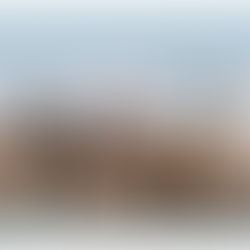This spectacular painting is set in Venice, Italy. In it, you can see the Church of San Giorgio Maggiore on the left and the Basilica di Santa Maria della Salute on the right across the Grand Canal. Now step into the painting and walk across the bridge you see before you. If you looked to the right and were able to see beyond the painting, you would immediately see the ornate and imposing Doge's Palace alongside the gilded St. Mark's Basilica, both on the vast Piazza San Marco. This painting, called 'Water Carriers, Venice' is by Frank Duveneck. While located in Cincinnati, it effortlessly transports us to sunny, hot Venice with its bustling life.
If you are not yet feeling the heat of the city and the splash of the canals' waters, then get a little closer and dip YOUR hand, and soul, into the painting below. Observe the ladies to the left busying themselves as they string glass beads, perhaps from Murano just across the lagoon. Consider ordering a plate of charcuterie paired with a glass of vino rosso from the prosciutteria on the right. Do you think the gawking guy leaning on the wall knows the confident woman holding the basket of clothes? I just love to "people watch" ... especially in Europe. This painting, also by Duveneck, is called 'Canal Scene with Washerwomen, Venice'.

Like most of you, MY soul is ready to go, ready to fly, and ready to travel to Europe. But we can't. NOT YET. BUT SOON. HOPEFULLY. In the meantime, the late 19th-century American Master painter, Frank Duveneck, transported my soul to Europe through his current exhibition at the Cincinnati Art Museum (CAM). Living in Louisville, Kentucky, I am a frequent visitor to our neighbor to the north ... Cincinnati. So this past weekend I visited the Cincinnati Art Museum specifically to view this exhibition which is showing until March 28, 2021.

What really makes this exhibition special to me, however, is that Frank Duveneck, shown in his self-portrait, above, actually WAS "my NEIGHBOR" as he both was born and lived in Covington, Kentucky, a mere hour north of Louisville. Duveneck was born in 1848 to German immigrant parents who settled in the German neighborhood of Covington, an area that still exists today. The charming 19th-century historic neighborhood, called Mainstrasse Village, retains its authentic architecture and is home to unique shops, quaint restaurants, beer and bourbon pubs, and galleries. It is in the adjacent neighborhood of Newport that I routinely visit the Munich-inspired, Hofbräuhaus, to indulge on Jägerschnitzle, German Potato Salad, and some fried cabbage prior to my return drive home. At some time, when we can travel again, I hope to visit "the REAL" Hofbräuhaus in Munich, Germany, pictured below.

Frank Duveneck was also attracted to Munich. In fact, he briefly left Covington, KY and temporarily moved to Munich, Germany at the young age of 21 years to study church decoration, likely oils for large altarpieces. But he soon had a change of heart, became more interested in smaller easel painting, and enrolled in the Royal Academy of Fine Arts in Munich. His talent did not go unnoticed as he quickly distinguished himself. Throughout the 1870s in Munich, he painted several works, opened his own studio, and even began his OWN art school, primarily teaching American expats studying in Munich. The flavor of his Munich compositions was generally DARK with broad, fast brushstrokes. He meshed an expressive contemporary German style with elements that he admired of the French Gustave Courbet and the 16th c. Old Dutch Masters, like Rembrandt.
Later, he traveled with his art students to Italy, spending time in both Florence and Venice throughout the 1880s. In the searing light of the Mediterranean sun, Duveneck's style was transformed. His paintings became brighter, more detailed, and his subject matters began to portray the exciting life and surroundings of Italy.
Frank Duveneck also held his own amidst the society portraits of his well-known American contemporaries, like James McNeill Whistler and even John Singer Sargent, an acclaimed portrait painter. In his sensuous painting of 'Miss Blood', shown below, you can see the creaminess of her porcelain skin, appreciate the layers of her skirt, the smoothness of her gloves, the lucidity of her sleeves, and feel the softness of her ostrich-feather purse.

In about 1890 he returned to Covington and began teaching regularly at the Art Academy of Cincinnati. He also taught in Chicago and New York City, exhibited in Boston, won several awards and served on many exhibition juries. He ultimately died in Cincinnati in 1919. After his death, a large grouping of his paintings, etchings, and sketches was donated to the Cincinnati Art Museum.

I personally found it very exciting to view the works of an American Master artist, neighbor, and Kentuckian. One who trained in Europe during the heights of Impressionism, Post-Impressionism, and Realism. One who had the very fortunate opportunity to carefully analyze and be REGULARLY in the presence of artistic works by the Dutch and Flemish Masters of Northern Europe, as well as those of the Italian Masters of the South. One who experienced the bursting of art during the Gilded Age in BOTH Europe and America.

As we are all hungry for international travel, art museums in general, and exhibitions such as that of Frank Duveneck's works at the CAM, allow our minds to travel and visit both Old Masters as well as works inspired by them. So, if you are in the Cincinnati area or within striking distance of it, then I strongly ENCOURAGE you to stop by the Cincinnati Art Museum and check out this exhibition. Afterward, take the bridge south across the Ohio River, and visit the 19th-century historic German district in Covington ... possibly even walking in Duvenick's footsteps. Or, stop by the Hofbrauhaus on 3rd St. in Newport and dive into some delicious German cuisine. Within those few hours the 'feeling' of Europe may, and hopefully, WILL, touch YOUR soul.




























Comments